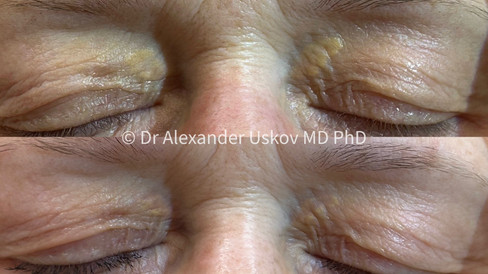Laser removal of xanthelasma
- gertnulk
- Aug 17
- 3 min read
Safe and aesthetically appropriate treatment at Dr. Uskov’s clinic

Xanthelasma palpebrarum is a benign formation that appears as soft, yellowish bumps, most often located on the upper or lower eyelid near the inner corner of the eye. Although xanthelasmas do not pose a health risk, they can significantly affect a patient’s appearance and cause considerable aesthetic discomfort.
At the clinic of international expert Dr. Uskov, we perform advanced laser removal of xanthelasmas, which allows the problem to be eliminated quickly, effectively, and with minimal risk to the surrounding tissues.
A relevant problem
Xanthelasma is one of the most common reasons for patients to consult a dermatologist or ophthalmic surgeon regarding aesthetic changes in the eyelid area. According to statistics, the condition most often develops in:
women over the age of 40,
patients with lipid metabolism disorders,
individuals with obesity, diabetes mellitus, or metabolic syndrome.
In many cases, xanthelasma is not only an aesthetic concern but also an external marker of a systemic disease. Therefore, when it is detected, patients are advised to undergo a parallel evaluation of their blood lipid profile.
Why choose laser treatment for xanthelasma removal?
Removal of xanthelasma in the eyelid area requires special precision. Laser technology provides exactly that, ensuring:
Accuracy — the laser selectively targets the lesion without damaging healthy skin
No bleeding — blood vessels are instantly coagulated
Minimal risk of scarring — especially important in the delicate eyelid area
Fast healing — recovery usually takes 3–8 days
Excellent aesthetic outcome — no stitches and no visible marks

How is the treatment carried out at Dr. Uskov’s clinic?
Consultation and examination
Before the procedure, an in-person consultation is conducted, during which the doctor:
assesses the depth and size of the xanthelasma,
performs digital dermatoscopy,
if necessary, conducts an UV-lamp examination or infrared imaging,
may recommend evaluation of lipid metabolism (if indicated).
If needed, differential diagnosis is carried out with other types of lesions (such as milia, lipomas, syringomas, etc.)
Laser removal
Technologies used: CO₂ laser, Er:YAG, and in some cases fractional non-ablative systems;
Anesthesia: local (topical application or injection);
Procedure duration: 10–15 minutes;
In most cases, one session is sufficient; rarely, an additional correction may be required after 6–12 weeks.
At Dr. Uskov’s clinic, only certified lasers with adjustable penetration depth are used, which ensures safe and precise treatment even near the lash line.
What do the results look like?
The individual result depends on:
the size and depth of the xanthelasma;
its location (upper or lower eyelid, near the inner corner of the eye);
the presence of any accompanying lipid metabolism disorders;
the patient’s age and skin condition;
adherence to post-procedure care recommendations.
Post-procedure care
After the treatment session:
a dry crust forms and falls off within 5–7 days;
swelling and redness usually subside within 2–3 days;
it is recommended to:
keep the area dry for the first 24–48 hours;
avoid sun exposure and use SPF 50+ cream for at least 4 weeks;
refrain from applying cosmetic makeup on the treated area for one week.
Patients receive a more detailed, individualized care instruction during the in-person consultation.
Safety is our top-priority
Work in the eyelid area requires the highest level of skill and precision. At our clinic:
procedures are performed by doctors with international qualifications in laser medicine;
premium medical equipment approved by the FDA and EU is used;
only minimally invasive protocols are applied, ensuring minimal risk of recurrence and complications.
An individual approach
Each case is unique. We take into account:
the patient’s skin type,
tendency to hyperpigmentation,
individual eyelid anatomy,
results of lipid metabolism tests,
psycho-emotional factors.
Treatment results, with before-and-after photos, are available on the website and during the consultation.
Xanthelasma is not just a “yellow spot” — it is a reason to pay careful attention to the condition of the skin and overall health. Timely laser removal helps not only to restore the aesthetic appearance of the eyes but also to prevent recurrence with a comprehensive approach.







